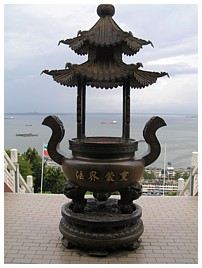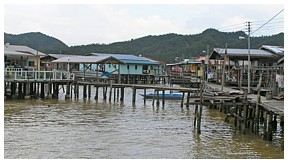|
 The island
of Borneo is shared by Sabah and Sarawak (parts of
Malaysia), Kalimantan (part of
Indonesia) and Brunei. Borneo
is almost completely covered by thick rainforest and many part of the island
are hard to reach. On the island live Chinese and Indian people, like in
other parts of Malaysia, but also more than 30 indigenous ethnic groups.
The largest group is the Kadazan Dusun. This group exists of two groups
- obviously, Kadazan and Dusun. They share the same language, which is taught
in school as second language, as they form almost 30% of the Sabah population.
They are active in hill rice cultivation. The Bajau, the second largest
group, also called sea-gypsies, were originally a seafaring crowd and therefore,
not only do they live in Borneo, but also in other parts of
Indonesia and the
Philippines.
They are Sunni Muslims and many of the now live in Kota Kinabalu. The island
of Borneo is shared by Sabah and Sarawak (parts of
Malaysia), Kalimantan (part of
Indonesia) and Brunei. Borneo
is almost completely covered by thick rainforest and many part of the island
are hard to reach. On the island live Chinese and Indian people, like in
other parts of Malaysia, but also more than 30 indigenous ethnic groups.
The largest group is the Kadazan Dusun. This group exists of two groups
- obviously, Kadazan and Dusun. They share the same language, which is taught
in school as second language, as they form almost 30% of the Sabah population.
They are active in hill rice cultivation. The Bajau, the second largest
group, also called sea-gypsies, were originally a seafaring crowd and therefore,
not only do they live in Borneo, but also in other parts of
Indonesia and the
Philippines.
They are Sunni Muslims and many of the now live in Kota Kinabalu.
Borneo is the third largest island of the world, between Greenland, New
Guinea and Madagascar. That was a bit of a change, coming from the tiniest
of tiny islands Lankayan! No walking
around the island this time, not even in good body condition. But then -
what is an island? Doesn't it totally depend on your definition? Why not
call Australia an island, or
Europe, for that matter?
Whatever the definition, after the island Lankayan we ended up on the island
Borneo, more specifically in Sabah, the North-Eastern part, where we visited
Sepilok, Sandakan and Kota Kinabalu.
Sabah belongs to Malaysia, but only since 1963. In and before the 15th century,
the kingdom of Brunei was the hierarchical and trade center of the island.
From 1521, the
Portuguese, and subsequently the
Spanish and the
Dutch tried
to set foot on the island in more than one ways. From the middle of the
18th century, the
British spread their influence through the British East
India Company and their agreements with the Sultan of Sulu. In 1888, North
Borneo, as it was called then, became a protectorate of
Great Britain. Between
1942 and 1945, the relative peace was rudely disturbed by the invasion of
the Japanese army, and in 1946, North Borneo became a crown colony of the
British. In 1963, North Borneo became officially part of independent
Malaysia and its name was changed to Sabah.
It is also called Negeri di bawah
bayu : land below the wind. before the 15th century,
the kingdom of Brunei was the hierarchical and trade center of the island.
From 1521, the
Portuguese, and subsequently the
Spanish and the
Dutch tried
to set foot on the island in more than one ways. From the middle of the
18th century, the
British spread their influence through the British East
India Company and their agreements with the Sultan of Sulu. In 1888, North
Borneo, as it was called then, became a protectorate of
Great Britain. Between
1942 and 1945, the relative peace was rudely disturbed by the invasion of
the Japanese army, and in 1946, North Borneo became a crown colony of the
British. In 1963, North Borneo became officially part of independent
Malaysia and its name was changed to Sabah.
It is also called Negeri di bawah
bayu : land below the wind.
Not all inhabitants
are happy being a part of the greater Malaysia: the government in Kuala
Lumpur takes 95% of the earnings of natural resources and the development
of Sabah is lacking behind, compared to the mainland. Sometimes, a call
for secession emerges, but up to now, even though Sabah has been autonomous
for a short time, the island remains part of Malaysia. The only difference
is, that you have to get a special stamp in your passport upon arrival.
Sandakan ("the place that was pawned"), on the East Coast, was almost flattened
during the Second World War. Now it is totally rebuilt and called "Little
Hong Kong". There is a lot of Chinese trade going on and many of the shops
have their names written in Chinese as well as in Malaysian. One of the
attractions is the Puu Gih Jih Chinese Buddha Temple, overlooking the Sandakan
bay. On the waterfront, many fishermen still live in houses on poles with
their families.
|
Kota Kinabalu (the city of the
Chinese widow, called just KK by the inhabitants of the island) is the capital
of Sabah. That was not always the case; in the 1880s, under the British
East India Company, it was Sandakan. KK is mainly a tourist resort and the
most interesting part in the neighborhood is Mount Kinabalu, a mountain
of more than 4,000 meters, which has hot sulfur springs. Unfortunately,
we could not see them, as there was construction going on when we were there.
We made one river trip, to visit the proboscis monkey. Borneo is the only
island where these monkeys can be found. We saw many of them, but unfortunately,
it was already getting dark and we were hardly able to see their noses.
Also, they kept showing us their backs, as if they were ashamed. The male
proboscis monkey namely has an enormous red drooping nose! But other
websites do have the pictures, if you are a nose-addict. We did see
macaque monkeys close by, as they were waiting for the daily tourists boats
full of people and watermelons. |
|
Apart from the
river trip, we mainly used our time for swimming, playing on the
beach and rafting. Rafting was a little more difficult than expected, and
the two boats we hired were upside down frequently. The boys got some more
excitement form the KK Adventure park, where they rode buggies and climbed
plastic mountains for an astronomic fee, while
Teb and
Anna were relaxing some more and
Elodie and me performed a shopping
hunt.
|